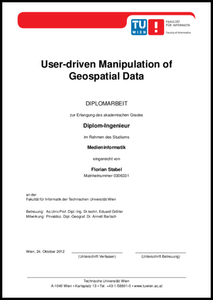Information
- Publication Type: Master Thesis
- Workgroup(s)/Project(s):
- Date: October 2012
- TU Wien Library:
- First Supervisor: Eduard Gröller
Abstract
A WebGIS is an application designed to store, analyze, manage and present geographical data. It provides tools which support users to explore and understand the underlying data. Depending on the datasource (raster or vector data), these tools are varying. Many more styling options for vector data than for raster data exist. This is because of the position information of vector data which allows the system to apply a wider range of styling features. This thesis is about user-driven manipulation of geospatial data and is part of the ESA DUE Permafrost project. It should help users to navigate through remote sensed data and to explore relevant features of it. Therefore it introduces methods to change the visualization of the data within a WebGIS by assigning different style profiles at runtime. The reference implementation is based on a specific software arrangement. The data is managed by GeoServer, an open source software server with the capability to edit and share geospatial data. To get a visual representation, GeoServer applies a Styled Layer Descriptor (SLD) on the data. A SLD is an XML based language and describes the appearance of associated layers. Modifying the SLD enables to influence the layer appearance. Since the data of the ESA DUE Permafrost project is of type raster only, this work concentrates on tools for styling raster data. As a result of this work, an interactive legend is introduced. It is a user interface and manipulates the SLD at runtime according to the user settings. This gives the user the capability to highlight areas of interest based on the underlying data. The user interface also acts as a color legend for the displayed data.Additional Files and Images
Weblinks
No further information available.BibTeX
@mastersthesis{Stabel_2012_UDM,
title = "User-driven Manipulation of Geospatial Data",
author = "Florian Stabel",
year = "2012",
abstract = "A WebGIS is an application designed to store, analyze,
manage and present geographical data. It provides tools
which support users to explore and understand the underlying
data. Depending on the datasource (raster or vector data),
these tools are varying. Many more styling options for
vector data than for raster data exist. This is because of
the position information of vector data which allows the
system to apply a wider range of styling features. This
thesis is about user-driven manipulation of geospatial data
and is part of the ESA DUE Permafrost project. It should
help users to navigate through remote sensed data and to
explore relevant features of it. Therefore it introduces
methods to change the visualization of the data within a
WebGIS by assigning different style profiles at runtime. The
reference implementation is based on a specific software
arrangement. The data is managed by GeoServer, an open
source software server with the capability to edit and share
geospatial data. To get a visual representation, GeoServer
applies a Styled Layer Descriptor (SLD) on the data. A SLD
is an XML based language and describes the appearance of
associated layers. Modifying the SLD enables to influence
the layer appearance. Since the data of the ESA DUE
Permafrost project is of type raster only, this work
concentrates on tools for styling raster data. As a result
of this work, an interactive legend is introduced. It is a
user interface and manipulates the SLD at runtime according
to the user settings. This gives the user the capability to
highlight areas of interest based on the underlying data.
The user interface also acts as a color legend for the
displayed data.",
month = oct,
address = "Favoritenstrasse 9-11/E193-02, A-1040 Vienna, Austria",
school = "Institute of Computer Graphics and Algorithms, Vienna
University of Technology ",
URL = "https://www.cg.tuwien.ac.at/research/publications/2012/Stabel_2012_UDM/",
}

 Poster
Poster Thesis
Thesis

